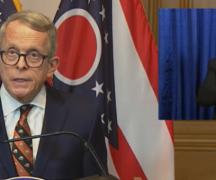By DAVID DUPONT
BG Independent News
Defying the distance imposed by COVID-19, the Toledo Symphony brass has come together virtually to perform.
Nine musicians, including the conductor Alain Trudel on trombone, recorded Giovanni Gabrieli’s Canzon duodecimi toni, each from their own studio. The result is now posted on YouTube.
The project was initiated by David Saltzman, the symphony’s tuba player and a faculty member at Bowling Green State University. The idea was to record the music written for 10 players with each part recorded separately, and brought together to create a whole. (The orchestra’s principal trombonist Garth Simmons recorded two parts.)
The project, Saltzman said, is an outgrowth of his teaching. He coaches tuba ensembles, and he was considering having them record using this technology. They include an ensemble that was preparing to premiere a new composition. So over spring break, when the initial interview took place, he was busy assembling power cords, computer cables and microphones in preparation.
He figured he might try it with professionals first. “This way I could learn a little bit before I go out in front of the students because I’m not an expert in all this. I’m learning on the fly.”
The Gabrieli project was also a way “the orchestra could remain relevant and do something together.”
The recording wouldn’t come out the way it would if all the musicians were in the studio at the same time. But “at least it’s something we can do together – a distraction to be doing something rather than sitting around waiting for something to happen.”
It proved, he said, “a lot harder than we thought.”
He optimistically hoped for St. Patrick’s Day. Instead the recording went up on April Fool’s Day.
The Gabrieli canzone, from his Sacred Symphonies, was selected because the 16th century Italian composer’s work is beloved by brass players.
It was originally composed for instrumental ensembles and choirs that provided the music in St. Mark’s in Venice.
The church has choirs lofts that face each other. Gabrieli used the architecture musically. The Canzone is written for two five-voice choirs. The musical lines from opposite sides mesh together to majestic effect.
Brass players often perform these works, and that familiarity was a plus as they embarked into this novel virtual venue. The music is comparatively simple, though by no means easy.
Saltzman got a click track, a metronome-like device used to record the music for film scores. The recording started with the orchestra’s principal trumpet Lauraine Carpenter laying down the lead line for the first choir.
Starting with the top was an unusual move. Most often Saltzman said they will tune from the bottom. Because his part is spare, no more than 50 measures of the three-and-a-half-minute work, it wouldn’t provide a solid enough foundation.
So, they started at the top. Then the other members of the first choir played their parts to Carpenter’s recording.
Not as easy as it sounds.
“Things we take for granted with regards to pitch and blend are very difficult when we can’t hear each other in real time, and we’re just reacting afterwards,” he said. There are minor intonation adjustments they make in the moment complicate synching 10 separately recorded parts.
And the video images have to be synched as well.
Some musicians had difficulty uploading the large data files.
Once the first choir completed its work, the individual members of the second choir played their parts to the recording of the complete first choir.
The final YouTube video includes individual frames showing the musicians as they perform. Other performers are: Thaddeus Archer, Katherine Cosgrove, Douglas Amos, Megan Shusta, and Emily Dietz.
It concludes with the message: “Wishing you health, peace, music and joy in these difficult times.”
Saltzman is employing that experience to work with his tuba studio. He’s experienced in teaching individual lessons remotely on Skype or Zoom, but this is a new venture.
The tuba quartet made up of younger players will switch to an easier piece to record.
“It’s a good learning experience,” he said. “Everything will be different no matter what we do.”
The tuba ensemble with 16-17 musicians is still on track to premiere the composition virtually. “It’s quite challenging,” Saltzman said. He’s considering recording each of the parts himself, so students can use them as a guide.
“It might be easier,” he said. “We’ll see how it all builds out.”
Students are also working with difficulties posed by stay at home orders. Some living in apartments may not have space to practice.
Even if a recording ends up being “subpar,” it’s still a good teaching tool, and one that will be helpful to students in the future when they will use digital media to push their music out to the public.
These virtual ensembles serve an emotional purpose. While it’s enjoyable to perform solo and to practice, “we’re community people,” Saltzman said.
Musicians are accustomed to being part of a larger group.
“Not having that as part of our daily life is hard for all of us,” he said. “We’re all in the same boat. The arts industry is nowhere right now.”





